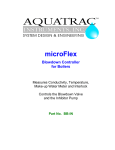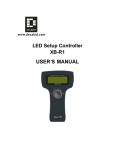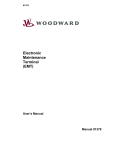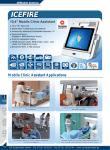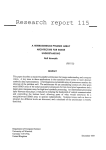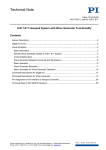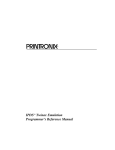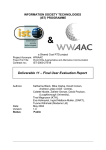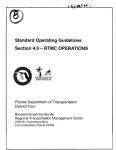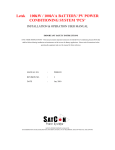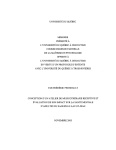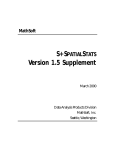Download Base Services Contract - Objective Operating Instruction
Transcript
Department of Defence Estate and Infrastructure Group BASE SERVICES CONTRACT OPERATING INSTRUCTION FOR OBJECTIVE AND DEFENCE INFORMATION MANAGEMENT October 2015 Base Services Contract Operating Instruction for Objective and Defence Information Management Page | 1 Version 4.0 16 October 2015 Authorisation The Base Service Contract Operating Instruction to Objective and Defence Information Management will be released under the authority of the undersigned. Gary Todd Director Data and Information Governance Estate and Infrastructure Group October 2015 Document review and Approval Revision History Version 0.9 1.0 2.0 3.0 & 4.0 Author DSO Data and Information Governance DSO Data and Information Governance ESD Data and Information Governance Data and Information Governance Date Revision May 2015 Reviewed Aug 2015 First version Sep 2015 Second version *Note: Defence Support Operations has changed to Estate Services Division. Objective naming of Workgroups and folders still uses DSO until otherwise advised/updated. Oct 2015 Third and Fourth Version This document has been approved by Name DDIG Gary Todd Signature Date reviewed Oct 15 Amendment Proposals for amendment to the Objective Instruction must be forwarded to the Director Data and Information Governance (DDIG). ii of 46 Table of Contents TABLE OF CONTENTS ......................................................................................................... III SECTION 1 – INTRODUCTION .............................................................................................. 5 Purpose ....................................................................................................................................................... 5 Priority of this Instruction ............................................................................................................................ 5 Scope of this Instruction............................................................................................................................... 5 Definitions ................................................................................................................................................... 5 Background.................................................................................................................................................. 6 Benefits of Using Objective .......................................................................................................................... 6 Security Classification of Documents ............................................................................................................ 7 Key Stakeholders ......................................................................................................................................... 8 Folder Structure Overview ........................................................................................................................... 9 SECTION 2 ‐ GETTING STARTED......................................................................................... 11 Overview ................................................................................................................................................... 11 Key Roles and Responsibilities.................................................................................................................... 11 Directorate Data and Information Governance ............................................................................................... 11 Defence National Work Group Coordinators ................................................................................................... 11 Defence Work Group Coordinators.................................................................................................................. 12 Product & Service Managers (Defence Sponsors)............................................................................................ 12 Contractor Work Group Coordinators.............................................................................................................. 12 Contractor Sponsor .......................................................................................................................................... 13 Contractor Objective User................................................................................................................................ 13 Getting access to the Defence Restricted Network and Objective ............................................................... 13 SECTION 3 – DIGITAL RECORDKEEPING AND INFORMATION & SYSTEM SECURITY............ 16 Digital Recordkeeping ................................................................................................................................ 16 Information and System Security Requirements ......................................................................................... 16 User Groups (Workgroup Groups) and Work Group Coordinator Groups....................................................... 17 Privileges .......................................................................................................................................................... 17 SECTION 4 – DEIS BUSINESS RULES ................................................................................... 19 Acceptable File Types................................................................................................................................. 20 Business Rules .................................................................................................................................................. 20 Document Scanning ......................................................................................................................................... 21 Imagery ............................................................................................................................................................ 21 Uploading Documents to Objective and Digital Storage Devices ................................................................. 21 Filing Documents in Objective.......................................................................................................................... 21 General Uploads to Objective .......................................................................................................................... 22 iii of 46 Defence Email................................................................................................................................................... 22 External File Servers Downloads ...................................................................................................................... 22 CD and DVDs .................................................................................................................................................... 22 Portable Electronic Devices – USB read‐only multi‐card reader ...................................................................... 22 USB Sticks and Portable Hard Drives................................................................................................................ 23 Objective to IBIS ............................................................................................................................................... 24 Documents / Records Generated Under Base Services Contracts ................................................................ 24 File Naming Convention ............................................................................................................................. 24 Metadata requirements for records in Objective ........................................................................................ 25 SECTION 5 ‐ SYSTEM SUPPORT – USEFUL LINKS ................................................................ 26 Annex A ‐ Estate Management Folders, Intended Use, Ownership and Key Stakeholders ............................ 27 Annex B – Defence National Work Group Coordinators .............................................................................. 28 Annex C ‐ Estate Management Folder Structure.......................................................................................... 29 Annex D – Estate Management Folders, Main User Groups......................................................................... 30 Annex E – Estate Management Folders, Folder Owners and Purpose of Folder Area.................................... 31 Annex F – Estate Management Folders (1 – 7) – Folder Hierarchy ............................................................... 32 Annex G – Flowchart: Contractor Access to Objective– Estate Management Folders ................................... 33 Annex H – Product and Service Line Matrix – Contract Authorities, Contractors and PSMs .......................... 34 Annex I – CAMPUS Screenshot showing Objective courses.......................................................................... 35 Annex J – Objective User Account Access Request via ICT Service Portal (Post CAMPUS Training)................ 36 Annex K – Objective Contractor Access Request Form to Estate Management Folders ................................ 37 Annex L – Minimum Scanning Specifications (Extract from RECMAN).......................................................... 38 Annex M – Document Descriptors, File Placement, Key Stakeholders and Estimated Document Size........... 39 Annex N – Objective Metadata Requirements – Extract of Catalogue (Draft)............................................... 43 Acronyms................................................................................................................................................... 45 iv of 46 Section 1 – Introduction Purpose 1.0 The purpose of this document is to provide the governance and operating instructions to the Estate Maintenance and Operations Services (EMOS) contractors , Miscellaneous Services Package (MSP) contractors and Estate Services Division (ESD) personnel for the lodgement, classification, maintenance and storage of estate management and contract related information. Adherence with this operating instruction will assist with consistent, compliant and efficient management of information. 2.0 Objective, Defence’s mandatory records and document management system, forms part of the Defence Estate Information Systems (DEIS). Priority of this Instruction 3.0 Ambiguity, inconsistency or discrepancy between this instruction and any of the Base Services Contracts and Commonwealth or Defence issued policy, will be interpreted in the following order of priority to the extent of any ambiguity, inconsistency or discrepancy: 3.1 Commonwealth Legislation; 3.2 Base Services Contracts; 3.3 Defence Policy; and 3.4 this Operating Instruction. Scope of this Instruction 4.0 5.0 This Operating Instruction covers: 4.1 the operating policy and use of Objective; 4.2 the purpose and structure of the Estate Management folder; 4.3 the use of the Estate Management sub‐folders including uploading of Estate related documentation to IBIS; 4.4 the Objective users’ roles and responsibilities and system support; 4.5 the document types typically required to be stored in Objective under the Base Services Contracts; and 4.6 file and document formats, specifications and naming conventions. Documents required to be stored in the National Spatial Information Management System (NSIMS) is subject to a separate Operating Instruction for NSIMS. Definitions 6.0 A Corporate file consists of a collection of documents, emails and objects that record an organisation’s business and policy decisions. A Corporate file can be one of the following within Objective: Virtual, Physical and Mixed mode. Virtual files are created in and managed by Objective, but have no physical equivalent, and contain only electronic documents. Physical files are created and handled physically, recorded in and managed by Objective. Mixed mode files contain both Virtual and Physical documents. Note that new physical files should not be created in the EM folder structure as files are expected to be supplied electronically. 7.0 Document is defined as an artefact that possesses information. It can be one or more of the following; word document, portable document format (PDF), spreadsheet, drawing, chart, map, image, scan, brochure, manual, certificate or any other item that is not broken down into a data string for inclusion into a database. 8.0 Data can be defined as the representation of raw, unorganised facts that need to be captured, stored or processed. Data can be something simple and seemingly random and useless until it is organised. IBIS and GEMS are the key data systems that EMOS and MSP contractors will interact with. The bulk of the data provided by the EMOS and MSP contractors to IBIS and GEMS will reflect changes made to the Defence Estate. These changes are referred to as modified Estate Master Data or more commonly referred to as Estate Records. 9.0 Defence Record. A Defence record is any document or object, in any form, that contains information relating to Defence activity, and is created, captured, managed or stored by any Defence personnel or external service provider in order to provide evidence of that activity. Background 10.0 Objective is Defence’s record management system mandated by the Defence Committee in November 2009. The system operates on both the Defence Secret and Restricted Networks and enables electronic documents to be managed through their entire life cycle, from creation through to review and once finished with, archival or disposal. 11.0 The National Archives of Australia has developed a Digital Continuity Policy for whole of government which requires all Commonwealth entities to move to a digital information and records management system by the target date of 2020. Digital Continuity targets for 2020 have been set by the Archives Minister and may be found at this web location: www.naa.gov.au. 12.0 Information provided by Contractors under the former sub‐regional contract model has been managed in an ad hoc and decentralised manner. Former document management arrangements were complicated by the fact that each Defence region had adopted different information management practices. This resulted in inconsistent processes for the storage, classification and retention of soft copy documents. Benefits of Using Objective 13.0 EMOS and MSP Contractors are required to register all Defence records generated and/or associated with the Defence Estate and required under their contract in Objective. These documents may be generated by the Contractor or their subcontractors or collected on behalf of Defence from another Contractor. 14.0 Contractors and ESD personnel utilising the Objective system in the prescribed way will eliminate many of the issues about the promulgation of information relating to the Defence Estate. 15.0 The registration of documents in Objective provides a number of benefits in supporting contractual activities. Documents uploaded into Objective will provide greater transparency of information to all stakeholders in a timely and secure way as well as providing a detailed audit of activity for each object registered. In addition, registration in Objective will: 15.1 form part of the ‘evidence’ that supports adherence to Commonwealth, State and local legislation, Defence and Commonwealth policy and contractual compliance associated with the Defence Estate; 6 of 46 15.2 support the sharing of intelligence between Contractors and Defence about the Defence Estate including its condition, risks, and maintenance; 15.3 inform decisions about the Defence Estate and contract obligations; 15.4 ensure Defence records relating to service delivery and contractual obligations are captured within a secure yet selectively transparent environment; 15.5 form part of the evidentiary trail that a contractor and/or Defence activity was performed; and 15.6 provide a central records storage facility in which documents can be retrieved, edited, reproduced, preserved, approved and archived. Security Classification of Documents 16.0 Documents stored in Objective have to be classified as either UNCLASSIFIED or For Official Use Only (FOUO). Documents classified as Protected must be stored in accordance with the relevant Defence Product and Service Manager (PSM) direction. All other classifications (SECRET/TOP SECRET) are not part of this instruction and documents classified higher than Protected must not be stored in Objective on the DRN. Table 1: List of Defence Security Classifications for Documents Document Definition Instruction Classification UNOFFICIAL The marking UNOFFICIAL may be This classification is NOT to be used. assigned to information that people All documents stored in Objective generate in their private capacity must be as a result of official business under reasonable use of Defence and/or contract activities. resource provisions. UNCLASSIFIED Official information that does not This classification can be used to store meet the criteria for the application documents in Objective as long as it of a security classification (see meets the classification criteria. paragraph 30.45) of the Defence Security Manual (DSM) is UNCLASSIFIED official information. 7 of 46 Document Definition Instruction Classification FOR OFFICIAL USE Official information that meets the This classification can be used as long ONLY (FOUO) criteria for FOUO. as it meets the classification criteria. FOUO documents can only be added to Objective via a DRN account. PSMs should be issued any additional handling instructions. PROTECTED Official information that meets the This classification can be used as long criteria set out for Protected. as it meets the classification criteria. Protected documents can only be added to Objective via a DRN account. Where a requirement for a document to be classified as Protected, the PSM should be notified of the intention to upload the document and any additional document handling instructions required before the document is uploaded to Objective. SECRET Not to be used in this instruction. Document with this classification must not be stored in Objective via the DRN. TOP SECRET Not to be used in this instruction. Document with this classification must not be stored in Objective via the DRN. Key Stakeholders 17.0 The Estate Management folder is set up in Objective so that stakeholders can create, register, store and locate documents relating to the Defence Estate, a Base Services contract deliverable or an estate development, investment, leasing, disposal or maintenance project. Key stakeholder groups include: 17.1 EMOS Contractors; 17.2 other Base Services Contractors; 8 of 46 17.3 Infrastructure Division Contractors; and 17.4 Estate Services Division Personnel. 18.0 Annex A provides a breakdown of stakeholders for the respective folders within the Estate Management area, including folder ownership and the nominated WGC. 19.0 A National Workgroup Coordinator group has been established to oversee the Estate Management (EM) Work Group in terms of Objective issues, structural and process changes. A list of members and their contact details are set out in Annex B. Folder Structure Overview 20.0 The EM Work Group and subordinate folders within Objective provides a centralised storage facility for documents relating to and associated with the Defence Estate and Base Services Contracts. 21.0 The folder structure within the EM Work Group provides four main areas which are outlined below and explained in Annex E. 22.0 Estate Management: Under each folder (1‐7), a “corporate file” is created for each Defence property. The EM folders (refer annex F), under the EM Work Group contain a corporate file for every Defence property regardless of whether it is owned, leased or subject to disposal. Each part of the Defence Estate is categorised according to its estate classification (refer Section 4 ‐ DEIS Business Rules for further information). Under folder “02 Defence Support – National”, each Base Services product and service has a folder to be used for their business purposes, as agreed with the individual PSM. 23.0 Documentation relating to a property must be stored in the correct folder under that property. DDIG are responsible for creating new folders in the EM folder structure to reflect changes made to the Defence Estate and the associated estate records held in IBIS. 24.0 A Base Services Contractor ‐ DEPOSIT BOXES: Each Base Services Contractor has a Deposit Box folder created for their use. These folders allow the Contractor, Product and Service Managers (PSMs), Contract Authorities (CAs) and any other Defence stakeholders to access the same information concurrently. It provides a staging area for documents so that stakeholders may quickly and easily view and perform necessary activities pertaining to that information. 25.0 The use of the Contractor Deposit Box areas will be largely determined by business needs and that which is arranged between the various stakeholders. Contractors may set‐up folders and subfolders within their Deposit Boxes to suit business needs, however, it is strongly recommended that the Product and Service line folders are maintained as a minimum. Refer to Annex D. 26.0 B Contract Administration Support – Contract Change Proposals: These folders will ultimately be available for use by each Base Services Contractor to upload Contract Change Proposals, edit information and track progress. Approved contract change proposals may be downloaded from this area. 27.0 C Defence Fuel Installation (DFI) Documentation: This folder currently stores some DFI documentation that is undergoing a migration activity to place these records within their respective Property File in the relevant Estate Management folders 03 – 07. Once this activity has been completed, the DFI folder structure will be removed. 28.0 D Estate and Facilities Services Project Documentation: This folder area provides a centralised storage area for historical project documentation traditionally kept by Estate and Facility Services. The folder is temporary until it is determined whether or not the information needs to be transferred to the EM folders. Contractors who require access to this information may access it upon request (refer to Annex A for WGC). 9 of 46 29.0 Other folders within the EM area may be created and removed as business needs require. For the creation or removal of folders under the EM area, contact DDIG or a National Work Group Coordinator. 10 of 46 Section 2 - Getting Started Overview 30.0 To access Objective, the minimum access requirements for users are: 30.1 a Baseline security clearance or higher; 30.2 a Defence Restricted Network (DRN) account; and 30.3 successful completion of the relevant CAMPUS online courses (see below). 31.0 Annex G provides a flowchart of the overall access process – it does not detail the sub‐processes as they are already established and instruction may be found on the Defence intranet. 32.0 Each Contractor must nominate a minimum of two WGCs. Users designated as a WGC must complete the Work Group Coordinator training found on CAMPUS online. The role of WGC is to provide assistance to their designated Objective users and is further defined under the Key Roles and Responsibilities under this section. It is not intended that Contractor WGCs (CWGCs) have access to internal Product and Service directorate management information, which is stored in the DSO work group rather than the Estate Management workgroup. Key Roles and Responsibilities 33.0 All Objective users have a responsibility to abide by Defence Information Management policies. In doing so, they are accountable for the appropriate handling of the records for which they are responsible. 34.0 The file structure in a Work Group is constructed and managed by the designated WGC, and should be designed around an effective structure for that business area. Defence has already created many of the sub‐folders in the Estate Management Work Group and has assigned Defence WGCs to help manage the folder areas. 35.0 The following roles provide an outline of key responsibilities for Contractors and Defence in managing Defence records within the Estate Management Work Group of Objective. Directorate Data and Information Governance 36.0 Data & Information Governance oversees the implementation of structures, policies, procedures, processes, data and controls to manage information and maintain quality and controls over data, in line with ESD requirements. In particular, DDIG provides the operating guidance for the use of ESD’s Objective system, folder structure, storage and naming of documentation including the metadata stored with each document. Defence National Work Group Coordinators 37.0 Made up of Principle and Work Group Coordinators, the Defence National Work Group Coordinator (NWGC) group has evolved as a result of change in ESD’s Operating Model. A list of Defence NWGC and their contact details is in Annex B. 38.0 NWGCs assist DDIG to ensure ESD’s information management standards are maintained. They are the liaison between DDIG, Objective Administration and other WGCs (Defence and Contractor). 39.0 NWGCs have a default access to all ESD Work Groups within Objective and facilitate Contractor Access to respective folders within the Estate Management area. NWGCs assist with the overall structure and management of DSOs Objective system. 11 of 46 Defence Work Group Coordinators 40.0 Work Group Coordinators (WGC) are those Objective users who have volunteered to provide assistance to others in the use of Objective. They complete an advance level of training in the use of the system and have additional responsibilities in ensuring that information management within the system conforms to Defence and Commonwealth government policy and legislation. 41.0 Work Group Coordinators assist with the day‐to‐day management of files, documents and local system structures for their respective business areas. WGCs assist NWGCs carry out activities in maintaining ESD’s Objective system. WGCs may also provide assistance to Contractor Objective Users if required. Product & Service Managers (Defence Sponsors) 42.0 Defence Product and Service Managers (PSM) (refer Annex H) work closely with their respective Contractor representatives. Objective provides an important platform for the interchange of information between PSMs and Contractors which helps facilitate collaborative interactions. 43.0 PSMs, as the Defence Sponsor for Contractors, will help provide administrative oversight of Contractors’ use of Objective. PSMs will help ensure that Objective is utilised appropriately by Contractor personnel with whom they deal and that the type and classification of documentation uploaded to the Objective system is appropriate. 44.0 Approval of document deliverables (in this case reports, plans, etc) by the PSM or the Contract Authority must continue as required under the contract; this includes the signing of the Deliverables Acceptance Certificate provided by the Contractor. Contractor Work Group Coordinators 45.0 Contractors, in managing the information within Objective associated with their contract and in assisting their personnel who have access to Objective, require WGC trained personnel. Contractor WGCs (CWGC) will have the responsibility to add and delete Objective users, set access privileges, create and delete folders within their area of responsibility and troubleshoot basic Objective issues. 46.0 CWGCs will be required to liaise with Defence’s NWGCs who may, from time‐to‐time, provide direction as to the appropriate management and maintenance of information within the system. Table 2: Summary Contractor WGC Responsibilities Objective/Folder Access Contractor WGC Responsibility Access to Objective As a Contractor Sponsor ‐ check and endorse Contractor Access Request Form – refer annex K. Stipulate access privileges for the User. If not a Contractor Sponsor, check and apply access privileges for Objective user. Access to Estate Management Folders 1‐7 Provide ‘See and Open’ access to respective Contractor users Access to A Base Services Contractor ‐ DEPOSIT BOX Provide access and privileges to Contractor users for respective folders Access to B Contract Administration Support – Change Contract Proposals Request access via Contract Administration Support WGCs – Siwaporn Bundao or Jeff Schofield. Must have Defence sponsorship via PSM 12 of 46 Objective/Folder Access Contractor WGC Responsibility Access to C Defence Fuel Installation Documentation DFI Documentation to be migrated into respective Property File in folders 03‐07. Access to D Estate and Facilities Services Project Documentation: Request access via Janine Bent – National Workgroup Coordinator. Must have Defence sponsorship via PSM. Contractor Sponsor 47.0 In conjunction with the procedure for accessing Objective, a representative for each Contractor is required to sponsor their employees’ access to respective Objective folders and files. It is recommended that the Contractor Sponsor is also a CWGC. 48.0 The Contractor Sponsor is required to keep an up‐to‐date record of their employees who have access to Objective. The Contractor Sponsor is to ensure that users who no longer require access or have left their organisation are removed from the relevant systems. For Objective, this requires the Contractor Sponsor to notify a member of the NWGC group so that they may effect the removal of access and update Defence’s access records. For removal of other system access, the Contractor Sponsor should follow the process for that system. Contractor Objective User 49.0 Contractor Objective Users’ (COU) within the Estate Management structure is determined at the individual level by the CWGC. The COU is expected to be responsible for the day‐to‐day management of documents into Objective in accordance with this instruction. 50.0 All Objective Users (Contractor or Defence) are responsible for notifying intended recipients within a timely manner of information uploaded to Objective for their use/reference. Whilst there is an ‘alert’ function within Objective, this is not to be relied upon for such notifications. Getting access to the Defence Restricted Network and Objective 51.0 Defence Restricted Network (DRN): A user must have a Baseline or higher security clearance to gain access to the DRN. PSMs are to approve the request for contractor personnel to have access to the DRN account as the (‘Defence Sponsor’). Details on how to go about doing this may be found through this link: New DRN Accounts ‐ electronic Network Access Request (eNAR) 52.0 The eNAR process eliminates the need to complete paper‐based forms. After the eNAR is submitted, it only takes approximately 30 minutes for a new DRN account to be available to the new user. At the end of the process, the new user will have the following: 53.0 52.1 A DRN account 52.2 An E‐mail account (including automatic inclusion on the relevant work site's email distribution list/s) 52.3 Access to some software applications listed in the eNAR tool (if requested during the eNAR process) 52.4 A personal storage area on their computer (H:\ drive) CAMPUS Online Training: To obtain access to Objective the following courses must be completed through the DRN online training interface, CAMPUS. The full 'Objective User Training' takes approximately two hours to complete and consists of five modules. 13 of 46 54.0 'Responsible Recordkeeping' ‐ Course ID: 00002642 (Prerequisite) ‐ The aim of the Responsible Recordkeeping course is to deliver training in correct records management practice and to outline the records management policies and processes in place in the Australian Defence Organisation. The course is designed to enhance awareness of baseline recordkeeping responsibilities. 55.0 'Objective User Training' ‐ Course ID: 00004767 (refer annex I) – The aim of Objective User Training is to provide trainees with basic knowledge and skill in the use of Defence’s mandated record management system. This online course is supported by the Objective User Manual videos found on the Objective One‐Stop‐Shop intranet site. 56.0 Contractors have the ability to access CAMPUS Anywhere. CAMPUS Anywhere is an unclassified version of Campus that allows people from the Defence community to access corporate web‐based training when not connected to the DRN (ie any internet‐connected computer). DRN users are able to request a Campus Anywhere account by logging into Campus and selecting the Request Access link from the Campus Anywhere portal on the Homepage. 57.0 Not all Campus courses will be available on Campus Anywhere due to course content and links to DRN information. Unfortunately, at the time of producing this Instruction, Objective User training, Responsible Recordkeeping and Work Group Coordinator training is not available on CAMPUS Anywhere. An enquiry into this has recently been submitted. The current solution is to log on to a DRN terminal to undertake the CAMPUS training. 58.0 Upon completion of the 'Objective User Training' course, Users will be asked to complete an 'Objective User Account' activation web page (refer annex G). Within a few days of entering the details, the DRN Service Desk will create the new Objective account. In completing the activation web page, Contractors are asked to request that an abbreviation of their company name be included in their Objective identification – refer table 3. For example: Reynolds, David Mr 6 (DSRG – EMOS – TSA) Table 3: List of Base Services Contractors and Objective Company ID Contractor Objective ID Transfield Services (Australia) Pty Ltd DSRG – EMOS – TSA Spotless Facility Services Pty Ltd DSRG – EMOS ‐ SFS Brookfield Global Integrated Solutions DSRG – EMOS ‐ BGIS MSS Security DSRG – MSP – MSS Wilson Security DSRG – MSP – WIL Compass DSRG – MSP ‐ COM Veolia DSRG – MSP ‐ VEO DTZ (formerly United Group) DSRG – MSP – DTZ Augility DSRG – MSP – AUG Aurecon DSRG – MSP ‐ AUR 59.0 Once the Contractor has received confirmation of the activated Objective account via email, they will need to liaise with their Defence Sponsor (the PSM) to gain access to the relevant Estate Management Work Group folders in Objective. 14 of 46 60.0 The Contractor and Defence Sponsor will need to complete an Objective Contractor Access Request form (refer annex K) to request access to specific folders within the Estate Management folder area. Contractors will need approval from their Contractor Sponsor to access Objective. This form assists information managers in keeping track of Contractor users and security and access controls. Once the Objective Contractor Access Request form is completed, Contractors are to submit the form via email to ESD Data and Information Governance for action. The email address is DSRG‐ [email protected]. 61.0 Defence Sponsors are to assist contractors requiring access to find a NWGC to implement the change on the system and sign‐off on the access request. Defence NWGCs will be able to provide access and sign‐off on Contractor access; however, it is expected that CWGCs will become proficient in the use of the system and manage their employees’ access and privileges as necessary. This will provide Contractors with greater flexibility and management over their employees’ access and activity within their folder areas. A list of Contractor WGC’s who may approve Contractor employees’ access will be provided once determined. 62.0 Once Objective user training has been completed, nominated Contractors may complete Objective Workgroup Coordinator training. This is a face‐to‐face course booked through Campus via the DRN intranet. This training provides users with greater detail about the functionality and use of Objective along with the Objective Work Group Coordinator Manual videos found on the Objective One‐Stop‐ Shop site. 15 of 46 Section 3 – Digital Recordkeeping and Information & System Security Digital Recordkeeping 63.0 Digital records are records created, communicated and/or maintained by means of computer technology. They may be ‘born digital’ (first created in electronic format) or they may have been converted into digital form from their original format (e.g. scans of hardcopy documents). 64.0 It is Australian Government policy to use digital recordkeeping to improve accessibility and reduce costs. Digital records must be stored in an approved recordkeeping system (i.e. Objective) and accessible for access requests under the Archives Act 1983 and Freedom of Information Act 1982. Records must not be stored on uncontrolled or unapproved systems which include email, personal or network drives. 65.0 Defence and Contractors may not destroy original source records after copying, conversion or migration if: 65.1 the record is identified as Retain as National Archives (RNA) or Retain Permanently and is pre‐ 1995 (these records must be transferred to National Archives of Australia (NAA) in original format); 65.2 there is a legal requirement to retain the record in its original format or a specific format; 65.3 there is a government policy, Executive Directive, NAA disposal freeze or Defence imposed embargo to not destroy the record; 65.4 the record may be required as evidence in a current judicial proceeding or a future judicial proceeding that will be commenced, or will likely be commenced; 65.5 the record is subject to a current application for access under the Freedom of Information Act 1982, Archives Act 1983 or other legislation; and 65.6 NAA has issued a notice that specifically requires retention of the record in its original format or a specific format. Information and System Security Requirements 66.0 The security of information for both Contractors and Defence is an imperative part of daily business. The following information has been extracted from Defence policy as it relates to the use of information systems and information management. For up‐to‐date details on security within Defence please refer to Defence Security Manual as a starting point. 67.0 Defence personnel and external service providers are subject to the terms and conditions of their contract and are bound by security policy contained in the DSM and Information Security Manual (ISM). Failure to comply with the mandatory requirements of the DSM and ISM may result in action under the relevant contract provision or legislation. 68.0 Whilst there is much to keep abreast of in terms of Defence security, the following are some core policy rules specifically for DRN users. A DRN user must: 68.1 Not allow another person to use their log‐on to access the DRN. 68.2 Lock their screen when leaving their workstation whilst logged onto the DRN. 16 of 46 68.3 Not reveal their password (to any system or device) to another person. 68.4 Never record their Password anywhere. 68.5 Not store or transmit inappropriate material via the DRN. 69.0 When engaged in off‐site work, including remote access, Defence personnel and external service providers must not allow people who are not appropriately cleared or do not have a need to know to view, overhear or otherwise access any official information which has not been authorised for public release. 70.0 A Data Spill is the introduction of information onto a network that is more highly classified than that for which the network is approved to store and process. Data Spills are classified as a major security incident due to the potential harm to national security that could result from unauthorised disclosure of classified information. All data spills are to be reported to a Security Officer in accordance with DSM Part 2:12 Security Incidents and Investigations. 71.0 Contractors accessing FOUO information will be required to have a Defence Industry Security Program (DISP) membership. For further information refer to DSM Part 2:42 Defence Industry Security Program. User Groups (Workgroup Groups) and Work Group Coordinator Groups 72.0 User Groups are another way to help manage access and security within Objective. A Workgroup User Group is a collection of users assigned to a Work Group. WGCs are able to provide assistance in creating or modifying User Groups. 73.0 CWGC must not create or make requests for new Work Groups or Work Group Coordinator Groups in Objective via Objective Administrators unless first approved by the Director (or authorised representative) of DDIG. Privileges 74.0 Privileges are the seven levels of permissions used to control access to objects in Objective – refer Table 4. Effectively applied privileges protect objects from unauthorised access. Privileges can be applied to objects (Work Groups, folders and files) to determine what tasks can be performed on those objects or on their contents. Privileges can be set at the user, Work Group, Folder, File or Object level. Table 4: The Seven Levels of Permissions – Objective Icon and Privilege Descriptions Action Description See The name of an object can be seen. Open The selected object and its properties window can be opened. Create Objects can be created within the structure, folder or file. Edit A user can edit the attributes of an object and the content of electronic documents. Delete An object can be deleted or moved. 17 of 46 Security A user with this privilege can assign others privileges to this object. Administrator Objective Administrator. Assigned all privileges. 75.0 Objective’s default access for folders and files is ‘see and open’. In most cases, however, information which has a particular audience is ‘locked down’ to that audience so that other users are unable to see the information. Consistent with the ‘need to know’ principle within Defence, Objective users must not access files containing information which does not concern them or the work that they do. Audit trails within Objective identify all activity relevant to folders, files and documents. 76.0 Privileges to a hierarchy of workgroups and folders should be applied in a pyramid structure. The most limiting privileges are assigned to the highest workgroups and folders. The increased privileges are applied in order as the groups and users are allocated to specific folders and files within the Workgroup structure. 18 of 46 Section 4 – DEIS Business Rules 77.0 The following business rules define the data and document relationship within the DEIS. These rules specifically apply to information which is associated with IBIS (and later GEMS) and that which is stored in the Estate Management folders (1 – 7). 78.0 Each estate item must be classified against the Estate Register Information Model (ERIM) structure. and must be categorised as one of the following: 78.1 Region; 78.2 Base Support Area; 78.3 Property; 78.4 Building; 78.5 Building Level; 78.6 Building Space; 78.7 Infrastructure; 78.8 Infrastructure System; 78.9 Land Space; 78.10 Equipment; 78.11 Equipment System; or 78.12 Hazard. 79.0 Each estate item must have a unique identifier (Estate ID) and each Estate ID must have one or more attributes that describes the estate item (refer to Estate Register Information Model Supplementary Information document). This is the Estate Master Data record. 80.0 Each Service Request (SR) registered in the EMOS, IBIS or GEMS systems must have a unique Service Request Number and each SR can have a minimum of one or more Work Orders (WO). Each WO must be uniquely identified and be associated with an Estate Item at the lowest possible level in the ERIM hierarchy. For example, if a service request is logged for an air conditioning problem it should be associated with the equipment item not the building. Noting the initial request may have the SR associated to a higher level estate item until the actual item is identified by the Contractor. 81.0 Each document registered in Objective must have a unique document ID (Objective ID) and it must include in the document name the Estate ID if it relates to or is associated with an estate item. 82.0 Where an Objective ID is related to an estate record they must be “linked” and the Objective ID entered in against the estate record held in the Contractor’s system, IBIS and GEMS. 83.0 Where the Objective ID is a result of a SR or a WO, the Objective ID must reference the unique SR or WO ID. All documents registered in Objective must conform to the correct naming standard allocated to the document class (type), per the current document. 84.0 If documents need to be visible within a 12 hour timeframe, they are to be uploaded and registered via the Deakin Objective Server (dknrdm02). Document recipients must log into this server to view the uploads. 19 of 46 85.0 For Base Services Contractor documentation, the details of each document registered in Objective must be captured through the submission of an IDS record in accordance with IDS DS.ALL.80.01 ‐ Documentation Update. Acceptable File Types Business Rules 86.0 Passwords must not be applied to documentation for any reason unless expressly agreed to in writing by DDIG. 87.0 The following file types are acceptable: File Type Comments Word Version 2003 or higher Excel Version 2003 or higher MS Project 2003 or higher Email records when stored in Objective must include both the email body and any attachments. Where an email ‘trail’ is captured retrospectively, only the last email in the trail (containing all the previous emails in MS Outlook 2003 or higher. the conversation) should be captured. If another email thread is started containing only some of the initial email threads then the subsequent threads should also be captured even if there is some duplication of content. MS Visio 2003 or higher For all PDF documents, all text should have Optical Character Recognition (OCR) applied. When providing PDF reports over 20 pages in length, apply Bookmarks to assist with navigation through the Adobe Portable Document Format (PDF) document. Files should be optimised where the reduction in file size does not affect the print quality or the ability to interrogate the content. Where feasible, native files should be provided along with PDF drawings, maps and plans. Plans, maps and other spatial information. Must be provided in accordance with the Spatial Data Management Plan (SDMP). 20 of 46 File Type Comments Acceptable method for reducing file size for transmission and can be opened on the DRN. ZIP Files Documents within Zip files must be extracted and placed in Objective individually. Document Scanning 88.0 Refer to Defence policy regarding minimum document scanning specifications required for all post‐ 1995 records and pre‐1995 temporary records. Destruction of physical records that have been digitised may only be performed in accordance with General Records Authority 31 (GRA 31). 89.0 Optical character recognition (OCR) is best practice and should be used for all documents containing text unless there is a specific business case against it. The OCR rendition of a record should be captured and managed in addition to, but not instead of the scanned images. 90.0 Defence has scanning metadata capture specifications which meets metadata requirements regarding process and methodology for records used in evidence. If scanning directly into Objective the metadata will be automatically captured, and tested using the Objective Desktop Scanning Tool. Chief Information Officer Group is responsible for managing the additional metadata script required for all digitisation projects on the Defence Restricted Network and Defence Secret Network. Imagery 91.0 To ensure that all Defence imagery maintains the highest possible value it must be controlled by standardised handling procedures and tagged with appropriate metadata. 92.0 DEF(AUST) GEO 7100 PART A defines the metadata standard for Hand Held Imagery (HHI). This metadata provides information relating to specific attributes of the image. The creator or originator of the image is responsible for capturing the specific metadata attributes. 93.0 Where there is no capability to have a recordkeeping metadata schema that allows for sentencing under the Archives Act 1983 or the ability to integrate with one, the database must be catalogued in an approved recordkeeping system. In addition to standard recordkeeping data, the catalogue entry for the HHI file must contain, as a minimum, metadata regarding the location, custodianship and accessibility of the HHI and a synopsis of the types of HHI the file contains. 94.0 Motion Imagery (MI) is imagery utilising sequential or continuous streams of images that enable observation of the dynamic behaviour of objects within the scene. Guidance for the management of Defence MI, including legacy MI, is found in DEF(AUST) GEO 7101. It comprises two parts: PART A describes the handling procedures for MI and PART B defines the metadata standards for MI. Uploading Documents to Objective and Digital Storage Devices Filing Documents in Objective 95.0 Annex M provides a list of document descriptors (for use in file naming convention – refer items 107 and 108) and guidance on where such types of documents will be placed and which stakeholder groups are likely to need visibility. 21 of 46 General Uploads to Objective 96.0 Defence’s DRN terminals do not allow drives, optical or magnetic media and other peripheral computing hardware devices unless they are Defence approved. This type of equipment must be appropriately managed and maintained and the facilities storing the equipment must protect the records and make them accessible. 97.0 Contractors may use CD or DVD discs to ‘burn’ documents to and from Objective and some terminals have scanners directly linked and available for use. 98.0 Digital storage devices deteriorate with time and use and are susceptible to dust and fluctuations in humidity, temperature and radiation. It is therefore important to ensure that stable environmental conditions are maintained. Software changes may also require format conversion to ensure that information remains accessible. Defence Email 99.0 Files received by DRN email are limited to a file size of 5MB and each Mailbox is limited to a maximum capacity of 900MB, after which point the Mailbox will not receive or transmit email messages. External File Servers Downloads 100.0 Information downloaded from an external file or web server for example, Dropbox or Send‐It, is held to the same provisions as external email; it is limited to information that is UNCLASSIFIED. An appropriate business case may be required to access some file servers beyond the Defence firewall. CD and DVDs 101.0 Defence DRN terminals are able to read both CDs and DVDs and copy files from the disks to the Desktop or DRN. Most terminal disk drives are able to write to CDs however not all have DVD write permissions. 102.0 If not enabled to burn files from the DRN, DVD/CD burning for file backup may be requested by using the Service Request Catalogue. Portable Electronic Devices – USB read-only multi-card reader 103.0 Portable Electronic Devices (PEDs) are devices that can process, store or communicate information electronically. Most PEDs also contain media, which may be removable or fixed within the device. Examples of PEDs that may be found within Defence include but are not limited to: 103.1 laptops, tablets, eReaders, phones, cameras, audio players/recorders; 103.2 data transfer and format converters, that transfer information between peripherals without the use of an intervening computer, such as portable Wi‐Fi hotspots, one touch backup drives, Serial Advanced Technology Attachment (SATA) hard disk to Universal Serial Bus (USB) converters and USB host transfer devices; and 103.3 cordless telephones such as Digital Electronic Cordless Telecommunications (DECT) phones and other wireless protocols including WiFi. 104.0 PEDs and media are to be afforded a level of protection commensurate with the classification of information they process or store and will be used in a way that will not compromise the official information or the security of ICT systems. 105.0 Policy for using PEDs outside of the office, conducting remote access to Defence systems from both privately owned and Defence controlled devices may be found in DSM Part 2:21 Off‐Site Work. 22 of 46 106.0 A USB Read‐only Multicard Reader facilitates the upload only of information from portable devices to the DRN. Users can upload appropriate data from personal devices (eg Digital Camera’s, Digital Voice recorders) that store data on removable flash memory cards such as SD, MicroSD and compact flash to the DRN. More information may be found on the Defence ICT intranet. USB Sticks and Portable Hard Drives 107.0 A USB thumb drive is a small device used to transfer files between electronic equipment/media devices or networks. A thumb drive may also be called Flash Drive, Pen Drive, Thumbnail Drive, USB Thumb Drive, Memory Stick, Micro Drive, Micro USB, and Zip Drive. 108.0 Only Defence accredited Portable Storage Devices may be used on DRN Terminals. The Defence Kanguru Defender 2000 (4GB) USB Thumbdrives are approved on Defence networks that are PROTECTED or below including the DRN. 109.0 The Defender 2000 should work on all workstations without further configuration. These drives can be purchased via Staples, Product Code: 18965646. User Registration forms are not to be completed or returned to Kanguru. 110.0 USB users must obtain, manage and use Defence supplied Kanguru Defender 2000 USB drive in accordance with applicable Defence IT policies. 111.0 To acquire an approved USB thumb drive for the purposes of this Operating Instruction, send an email requesting a USB thumb drive and including the name, phone number and email address of the responsible person(s) to your Contract Authority mailbox, CC’ing DSRG‐[email protected]. The Contract Authority will purchase a Defence approved USB drive from Staples. The Contract Authority will provide a letter to the contractor requiring signing for the USB drive and agreeing terms of use as per policy and CIOG site. The USB drive must be returned to the Contract Authority when use has finished. 23 of 46 Objective to IBIS 112.0 The following flow diagram provides an overview of the process for uploading Estate Management documentation (folders 1 – 7) to IBIS via Objective. Documents / Records Generated Under Base Services Contracts 113.0 The EMOS Contract Authority has developed a Reports and Plans Deliverables (RPD) Register for PSMs, Contractors and CAs showing the list of documents required under the Contract, when they are due and who the key recipient is for that document. A column has been included in this register to indicate where the RPD should be placed in Objective when submitting, reviewing and/or transferring the document(s). This is currently being populated. File Naming Convention 114.0 In general, Objective’s file naming convention provides that: 114.1 all object titles in Objective are written in title case, for example: Remembrance Day Ceremonial Parade 114.2 commas, colons and semi colons must not be used in a title; 114.3 hyphens can be used in titles; 114.4 abbreviations and acronyms should be written in full; 114.5 classification caveats must not be used in a title; 114.6 file names must be logical and detailed; 114.7 file titles must not contain sensitive information (such as personal details); 24 of 46 114.8 115.0 all file names must be unclassified; For Estate related documentation which is placed in the Estate Management, folders 1 – 7, the following naming convention will apply: [Unique Property ID]<>[Document Type]<>[Document Date]‐<>[BSC Unique Identifier] Eg: 1012/A011 Fire Safety Survey 20150219‐S0385 116.0 Unique Property ID – this ID can be found in the IBIS Estate Register via the DRN Online Portal or in the Estate Register extract provided to Base Services Contractors under the Attribute 1035. 117.0 Document Type – document descriptions are taken from the IBIS Allowed Values List “ALL.AVL.41 Document Type”. Acronyms for each are found at Annex M. Where the acronym is generic, additional descriptive words may be included, for example, Business Case is one descriptor, BC is its acronym; however, for the file name to become more meaningful it could be adapted to ‘BC ‐ New Generators’. Folders for each unique Estate Register Item will be created upon request by Defence. 118.0 BSC Unique Identifier – at the request of BS Contractors, this provides for an identifier for tracking of documents in BS Contractor systems. It does not need to be populated and is not parsed by Defence. Defence do not need to use this when placing documents in the EM folder. 119.0 Document date – is the date which the document has been provided to Defence. 120.0 Objective allows duplicate files names because each object has a unique identifier. All documents in the EM area – folders 1 – 7 which link with IBIS will be required to have the same naming convention as identified above. Metadata requirements for records in Objective 121.0 All digital Defence records must comply with the metadata standards described in the Australian Government Recordkeeping Metadata Standard 2.0 (AGRkMS). 122.0 For Estate related documentation which links with IBIS, custom metadata catalogues for Objective files are currently being investigated. It is envisaged that once criteria has been determined, creation of the catalogues will take approximately six months. 123.0 See Annex N for metadata requirements based on existing Objective metadata fields. 25 of 46 Section 5 - System Support – Useful Links 124.0 Objective Online Support – log a request via the Service Request Catalogue 125.0 Objective User Account Request 126.0 Objective One‐Stop‐Shop 127.0 Objective User and WGC Manuals: Refer to the One‐Stop‐Shop "Resources" tab 128.0 Objective Training Enquiries / Nominations Refer to the One‐Stop‐Shop "Training" 129.0 Objective Help‐desk – in addition to being able to log a request/service job via the ICT online portal, telephone enquiries may be made by calling 133 272 130.0 Records Management Policy Intranet Site 131.0 Defence Public‐Key Infrastructure (PKI) ‐ Defence Internet 132.0 Defence Public Key Infrastructure ‐ Defence Intranet ‐ CIOG 133.0 Digital Signatures ‐ Benefits 134.0 Contractor access and process queries for the Estate Management folder area, please contact one of the National WGC identified in Annex A. 26 of 46 Annex A - Estate Management Folders, Intended Use, Ownership and Key Stakeholders Estate Management Documentation (Folders 1 – 7) Contractor Deposit Boxes Contract Change Proposals Defence Fuel Installation Typical Use of Folders Storage of Estate Related documentation connecting with IBIS / GEMS systems Transfer of Contract related / associated information Includes area for ECART Monthly Reporting and Contract Deliverables Reports and Plans Facilitate Contract Change Proposal process Document migration activity to relevant Property File underway. Estate and Temporary storage Facilities Services location for project – Project documentation Documentation historically (interim folder) maintained by EFS – may need transferring to the Estate Management Documentation (Folders 1 – 7) Key Stakeholders All BSR Contractors , Infrastructure Division, Estate Works Program Office, DSRG Personnel Contractors, PSMs, CAs Default Access Contractors, CAS, PSMs, CAs N/A Regional EFS, NPS/PDS, Estate Upkeep, Estate Works Program Office Contractors, Infrastructure Division Folder Ownership Directorate of Data and Information Governance Defence WGC Mr Jeff Schofield/ Mr Michael Kovacs Restricted to individual Contractors, PSMs, CAs and other Defence stakeholders as necessary EMOS Contract Authority Ms Jennifer Commegno / Mr David Stint/Mr Jeff Schofield Restricted to individual Contractors, PSMs, CAs and other Defence stakeholders as necessary N/A Contract Administration Support (Directorate of Contract Governance) Ms Siwaporn Bundao / Mr Jeff Schofield N/A Jeff Schofield Regional Estate and Facility Services Ms Janine Bent/Mr Jeff Schofield Open access to all Contractors and Defence Personnel Open access to all Contractors and Defence Personnel 27 of 46 Annex B – Defence National Work Group Coordinators First Name Last Name Objective Id Region Position Directorate Email Telephone Jennifer Commegno uD3271 Central & West Contract Manager - EMOS Contract Authority Directorate Base Services Management Integration & Coordination [email protected] 08 7383 0419 Andrew Clough uA15841 Central & West RIM - Estate & Facility Services Central & West Estate & Facility Services Central & West [email protected] 08 7383 0374 Fred Grocke uD1429 Central & West Customer Services Manager SA Defence Support - SA [email protected] 08 7383 3008 Brian Holland uA16566 Central & West Defence Records Management - SA Defence Support - SA [email protected] 08 7389 6493 Jeff Schofield uG2812 Northern NSW Information Manager - DSNNSW Defence Support - NNSW [email protected] 02 4034 7666 Janine Bent uL155 Southern NSW Regional Corporate Information Manager - RMV Defence Support - RMV [email protected] 02 6055 2161 Michael Kovacs uX28792 Northern NSW Data Compliance Officer - DSNNSW Directorate Data & Information Governance [email protected] 02 9393 2426 Sandra Sumpton uA28765 Queensland Customer Service Officer Defence Support - QLD [email protected] 07 3332 6400 Siwaporn Bundao uK358 Northern NSW Contract Administrator Directorate Contract Governance Contract Administration Support [email protected] 02 9393 2043 Katherine Butler uR2489 Branch EA to HDSO Head Estate Services Division [email protected] 02 6265 6138 Ruihana Hepi uR1932 Branch Executive Officer - Estate Support Estate Support [email protected] 02 6266 2891 Janelle Gilbert uQ418 Executive Assistant to DGBPESP Directorate Base Planning, Engagement and Service Performance [email protected] 02 6266 4942 Christine Amos uA25100 Branch Northern NSW Information Coordinator Defence Support - Northern NSW [email protected] 02 4034 8338 John Vanderdonk uC1640 Central & West Contract Officer Directorate Base Services Management Integration & Coordination [email protected] 08 9311 2235 Mira Kovac uR3675 [email protected] 03 9282 3609 David Stint uD6016 [email protected] 08 7383 0160 Vic / Tas Central & West Regional Integration & Coordination Officer Contract Administration Officer Regional Integration & Coordination Vic/Tas Directorate Base Services Management Integration & Coordination Annex C - Estate Management Folder Structure ESTATE MANAGEMENT DOCUMENTATION (FOLDERS 1 – 7) CONTRACTOR DEPOSIT BOXES INCLUDING CONTRACT DELIVERABLE REPORTS REGISTER Access to the Contract Change Proposal area is currently closed to Contractors. Access to be provided in due course… CONTRACT CHANGE PROPOSAL DOCUMENTATION DFI DOCS TO PROPERTY FILE ACTIVITY EFS PROJECT DOCUMENTATION (TEMPORARY) Annex D – Estate Management Folders, Main User Groups Example Only ‐ Zoom In to see detail Level 3 Level 4 Level 5 Level 6 Level 7 Level 8 Container Type Navigational Navigational Functional Functional Operational Navigational Estate Management Workgroup Work Group Folder 01 International Folder 02 National Folder 03 Northern NSW Folder 04 Queensland IBIS Estate Management Document Folders 1 - 7 Folder 05 Southern NSW Folder 06 Victoria & Tasmania Folder 07 Central & West Folder A Base Services Contractors - Deposit Boxes Folder 1.0 Transfield Services Deposit Box Folder 1.1 MIC Folder 1.2 BSSC Folder 1.3 Commercial Ops Folder 1.4 Special Forces Training Folder 1.5 Training Areas and Range Management Folder 1.6 Transport Folder 1.7 Airfield Ops Folder 1.8 Estate Upkeep It is recommended that Folder 1.9 Laundry & Drycleaning folders for each Folder 1.10 Land Management Product & Service line User Groups Directorate Data & Information All DSO (Incl BS Contractors) Directorate Data & Information All DSO (Incl BS Contractors) Directorate Data & Information All DSO (Incl BS Contractors) Directorate Data & Information All DSO (Incl BS Contractors) Directorate Data & Information All DSO (Incl BS Contractors) Directorate Data & Information All DSO (Incl BS Contractors) Directorate Data & Information All DSO (Incl BS Contractors) Contractors, Relative PSMs and CA Jen Commegno / David Stint Transfield Only, Relative PSMs and CA TBC - PSM (Interim J Commegno) Transfield Only, Relative PSMs and CA TBC - PSM (Interim J Commegno) Transfield Only, Relative PSMs and CA TBC - PSM (Interim J Commegno) Transfield Only, Relative PSMs and CA TBC - PSM (Interim J Commegno) Transfield Only, Relative PSMs and CA TBC - PSM (Interim J Commegno) Transfield Only, Relative PSMs and CA TBC - PSM (Interim J Commegno) Transfield Only, Relative PSMs and CA TBC - PSM (Interim J Commegno) Transfield Only, Relative PSMs and CA TBC - PSM (Interim J Commegno) Transfield Only, Relative PSMs and CA TBC - PSM (Interim J Commegno) Transfield Only, Relative PSMs and CA TBC - PSM (Interim J Commegno) Transfield Only, Relative PSMs and CA Folder TBC - PSM (Interim J Commegno) Transfield Only, Relative PSMs and CA Folder TBC - PSM (Interim J Commegno) Transfield Only, Relative PSMs and CA 1.13 Housekeeping Folder TBC - PSM (Interim J Commegno) Transfield Only, Relative PSMs and CA 1.14 Base Reprographics Folder TBC - PSM (Interim J Commegno) Transfield Only, Relative PSMs and CA 1.15 Sport & Recreation Folder TBC - PSM (Interim J Commegno) Transfield Only, Relative PSMs and CA 1.16 H & C Folder TBC - PSM (Interim J Commegno) Transfield Only, Relative PSMs and CA 1.17 Rescue & Fire Fighting Folder TBC - PSM (Interim J Commegno) Transfield Only, Relative PSMs and CA 1.18 Aircraft Refuelling Folder TBC - PSM (Interim J Commegno) Transfield Only, Relative PSMs and CA 1.19 POL Folder TBC - PSM (Interim J Commegno) Transfield Only, Relative PSMs and CA 1.20 Retail Stores Folder TBC - PSM (Interim J Commegno) Transfield Only, Relative PSMs and CA 1.21 ECART - EMOS Contract Authority Reporting Tool Folder TBC - PSM (Interim J Commegno) Transfield Only, Relative PSMs and CA Spotless Only, Relative PSMs and CA 1.12 Cleaning be maintained. WGCs may add folders if required. 2.0 Spotless Facility Services Deposit Box Folder Jen Commegno / David Stint 3.0 Brookfield Johnson Control Deposit Box Folder Jen Commegno / David Stint BJC Only, Relative PSMs and CA 4.0 Compass Deposit Box Folder TBC (Interim J Commegno) Compass Only, Relative PSMs and CA 5.0 Wilson Security Deposit Box Folder TBC (Interim J Commegno) Wilson Only, Relative PSMs and CA 6.0 MSS Security Deposit Box Folder TBC (Interim J Commegno) MSS Only, Relative PSMs and CA 7.0 Veolia Deposit Box Folder TBC (Interim J Commegno) Veolia Only, Relative PSMs and CA 8.0 United Group Deposit Box Folder TBC (Interim J Commegno) United Group Only, Relative PSMs and CA 9.0 Augility Deposit Box Folder TBC (Interim J Commegno) Augility Only, Relative PSMs and CA Folder TBC (Interim J Commegno) Aurecon Only, Relative PSMs and CA 10.0 Aurecon Deposit Box Folder Siwaporn Bundao / Jeff Schofield Contractors, CAS, DPCB, Relative PSMs and CA Transfield Services Deposit Box Folder Siwaporn Bundao / Jeff Schofield Transfield Only, CAS, Relative PSMs and CA Spotless Facility Services Deposit Box Folder Siwaporn Bundao / Jeff Schofield Spotless Only, Relative PSMs and CA Brookfield Johnson Control Deposit Box Folder Siwaporn Bundao / Jeff Schofield BJC Only, Relative PSMs and CA Compass Deposit Box Folder Siwaporn Bundao / Jeff Schofield Compass Only, Relative PSMs and CA Contract Administration Support - Contract Change Proposals Wilson Security Deposit Box C Contractor Information Manager / POC Jen Commegno / David Stint 1.11 Pest & Vermin B Defence Work Group Coordinator Folder Ownership Folder This Contract Administration Support Area is still under development. It is a staging area for managing Contract Change Proposal documents. Wilson Only, Relative PSMs and CA Siwaporn Bundao / Jeff Schofield MSS Security Deposit Box Folder Siwaporn Bundao / Jeff Schofield MSS Only, Relative PSMs and CA Veolia Deposit Box Folder Siwaporn Bundao / Jeff Schofield Veolia Only, Relative PSMs and CA United Group Deposit Box Folder Siwaporn Bundao / Jeff Schofield United Group Only, Relative PSMs and CA Augility Deposit Box Folder Siwaporn Bundao / Jeff Schofield Augility Only, Relative PSMs and CA Aurecon Deposit Box Folder Siwaporn Bundao / Jeff Schofield Aurecon Only, Relative PSMs and CA Folder John Vander Donk / Jen Commegno All DSO (Incl BS Contractors) Defence Fuel Installation (DFI) Documentation Access / Privilege Level Annex E – Estate Management Folders, Folder Owners and Purpose of Folder Area Level 3 Navigational Level 4 Navigational Level 5 Navigational Level 6 Functional Level 7 Functional Level 8 Operational Container Type Work Group Coordinator Work Group Defence: Jen Commegno / Andrew Clough 01 International Folder DDIG 02 National Folder DDIG 03 Northern NSW Folder DDIG 04 Queensland Folder DDIG 05 Southern NSW Folder DDIG 06 Victoria & Tasmania Folder DDIG 07 Central & West Folder DDIG A Folder Defence: Jen Commegno / Dave Stint 01 Transfield Services Deposit Box Folder Contractor TBA (Defence: Jen Commegno / Dave Stint) 02 Spotless Facility Services Deposit Box Folder Contractor TBA (Defence: Jen Commegno / Dave Stint) 03 Brookfield Johnson Control Deposit Box Folder Contractor TBA (Defence: Jen Commegno / Dave Stint) 04 Compass Deposit Box Folder Contractor TBA (Defence: Jen Commegno / Dave Stint) 05 Wilson Security Deposit Box Folder Contractor TBA (Defence: Jen Commegno / Dave Stint) 06 MSS Security Deposit Box Folder Contractor TBA (Defence: Jen Commegno / Dave Stint) 07 Veolia Deposit Box Folder Contractor TBA (Defence: Jen Commegno / Dave Stint) 08 United Group Deposit Box Folder Contractor TBA (Defence: Jen Commegno / Dave Stint) 09 Augility Deposit Box Folder Contractor TBA (Defence: Jen Commegno / Dave Stint) 10 Aurecon Deposit Box Folder Contractor TBA (Defence: Jen Commegno / Dave Stint) Folder Siwaporn Bundao/Jeff Schofield Folder John Vanderdonk / Jen Commegno Folder Janine Bent Estate Management Workgroup B C D Base Services Contractors - Deposit Boxes Contract Administration Support - Contract Change Proposals Defence Fuel Installations Estate and Facility Services Project Documentation Comments Folder Ownership This Work Group folder and sub-folders '01 to '07 have been se for the storage of Estate documentation requiring linkage to IBIS Default Access to these folders '01 to '07 should be set at 'See Open' for all Objective Users. DDIG is the owner of these folders and are responsible for crea modifying and deleting information in this area of the Estate Management folder. Contractor WGCs will not have privileges t make these changes. These folder areas are set up for each Base Services Contracto transfer information between Contractors and Defence which do need to be placed in the other areas of the Estate Management structure. Contractor WGCs are responsible for managing the information, structures and access within their organisation's W Group. Defence National Workgroup Coordinators also have ac to make changes within these folders, however, this will be done consultation with the respective Contractor WGC. Overall, DDIG is the owner of these folders and reserves the rig make whatever changes, restrictions, etc deemed necessary in meeting Defence information management needs. Contract Administration Support currently provide this folder are PSMs and CAs. Once Contractor access is determined, they to may have access to their specific CCPs. DFI documentation being migrated into relevant Property File. DFI Folder structure to be removed a once completed. This is an interim folder for EFS Project Documentation predominantly for Defence use until a permanent location is ide for this information. Contractors may have access to this inform upon request via Janine Bent (WGC) 31 of 46 Annex F – Estate Management Folders (1 – 7) – Folder Hierarchy Annex G – Flowchart: Contractor Access to Objective– Estate Management Folders Annex H – Product and Service Line Matrix – Contract Authorities, Contractors and PSMs Central & West DS QLD DS NNSW DS SNSW VIC / TAS CA Region CA PSM Region PSM MIC (incl Estate Appraisal) Transfield Spotless Brookfield Spotless Transfield RD C&W Ron Hunter C&W (DBSMIC) Simon Buckley Base Services Support Centre (BSSC) Transfield Spotless Brookfield Spotless Transfield RD C&W Ron Hunter C&W (DBSMIC) Simon Buckley Commercial Ops Woomera (COW) Transfield N/A N/A N/A N/A RD C&W Ron Hunter C&W (DBSMIC) Simon Buckley Special Forces Training Facilities (SFTF) Transfield N/A Brookfield N/A N/A RD C&W Ron Hunter Training Areas and Range Management Transfield Spotless Brookfield Spotless Transfield RD C&W Ron Hunter C&W (DBSMIC) DG BPESP (DOTAM) Service Lines Simon Buckley Col David Graham Transport Transfield Spotless Brookfield Spotless Transfield RD C&W Ron Hunter Airfield Ops Transfield Spotless Brookfield Spotless Transfield RD C&W Ron Hunter Estate Appraisal Transfield Spotless Brookfield Spotless Transfield RD C&W Ron Hunter ASES (DEPU) Marcus Jeffery Estate Upkeep Transfield Spotless Brookfield Spotless Transfield RD C&W Ron Hunter Marcus Jeffery Laundry & Dry Cleaning Transfield Spotless Brookfield Spotless Transfield RD C&W Ron Hunter Land Management Transfield Spotless Brookfield Spotless Transfield RD C&W Ron Hunter Pest & Vermin Transfield Spotless Brookfield Spotless Transfield RD C&W Ron Hunter Cleaning Transfield Spotless Brookfield Spotless Transfield RD C&W Ron Hunter Housekeeping Transfield Spotless Brookfield Spotless Transfield RD C&W Ron Hunter N/A Spotless N/A Spotless N/A RD C&W Ron Hunter Transfield Spotless Brookfield Spotless Transfield RD C&W Ron Hunter ASES (DEPU) DS QLD (DGUS) DS SNSW (DLMU) DS SNSW (DLMU) DS SNSW (DLMU) DS SNSW (DLMU) DS VT DLIS DS QLD (DGUS) Base Reprographics Sport & Recreation Access Control DS VT (DTAFS) Bob Hogan DS VT (DTAFS) Bob Hogan Craig Mills Julie Groenendijk Julie Groenendijk Julie Groenendijk Julie Groenendijk Carl Fitchett Craig Mills CDRE Jaimie Hatcher Gerald Griffin/Ron Hunter Julie Groenendjik DG BPESP (DBSSP) Dan Curtis DS QLD (DGUS) Craig Mills DS SNSW (DLMU) Julie Groenendijk DS VT (DTAFS) Bob Hogan Inger Carpenter [Acting] Wilson MSS Security MSS Security Wilson Wilson DG BPESP Transfield Compass Compass Compass Transfield RD QLD/RD C&W Veolia Veolia Veolia Veolia Veolia RD SNSW Rescue & Fire Fighting Transfield Transfield N/A Transfield Transfield RD C&W Ron Hunter Aircraft Refuelling Transfield Transfield N/A Transfield Transfield RD C&W Ron Hunter ASES (DFRS) POL Transfield Transfield Transfield Transfield Transfield RD C&W Ron Hunter ASES (DFRS) Inger Carpenter [Acting] Retail Stores Transfield Transfield Transfield Transfield Transfield RD C&W Ron Hunter United Group United Group United Group United Group United Group ASES Mike Healy Project Delivery Service (PDS) Augility and Aurecon Augility and Aurecon Augility and Aurecon Augility and Aurecon Augility and Aurecon ASES Mike Healy ASES (DFRS) ASES (DEWPO) ASES (DEWPO) Inger Carpenter [Acting] Directorate of Contract Governance Contract Administrator - Coordinates B2B; Strat Review and DSO Input to BSCC meetings. Guidance on interpretation of T&Cs DS NNSW Dana Reddy DS NNSW (DCG) Dana Reddy Contract Administration Support Contract Support (CCPs; Contract notices; VFM assessment of CCPs; contract extensions; purchase orders; tracking price indexation; processing abatements; maintaining contract documents and price schedules) DS NNSW Dana Reddy DS NNSW (DCG) Dana Reddy H&C Waste National Program Service (NPS) Kevin Fogarty Kevin Fogarty Annex I – CAMPUS Screenshot showing Objective courses Annex J – Objective User Account Access Request via ICT Service Portal (Post CAMPUS Training) Annex K – Objective Contractor Access Request Form to Estate Management Folders Example Only Annex L – Minimum Scanning Specifications (Extract from RECMAN) Table 4A.1: Records types and standards Record Type For clean, high contrast documents with text or graphics, for which colour is either not present or not essential, and for any images that are line art, Defence must produce images conforming to these specifications or higher. Generally this specification for documents may be used unless any of the following conditions apply: The document contains colour information that must be retained to preserve the meaning; The document has a low contrast (eg faded text, browning paper, or coloured paper); or The document includes photographs, is a photograph or a negative. Please Note: documents with coloured letterheads, wet signatures (unless they have Standard Quality Check Format JPEG 2000, PDF/A, Testing of the TIFF images to ensure that the minimum requirements listed in these technical specifications have been met. Multi page format PDF/A Resolution 300 dpi Scanning ratio 100% Type of image greyscale Bit-depth 8 bit Compression lossy Searchability OCR Recommended 38 of 46 Annex M – Document Descriptors, File Placement, Key Stakeholders and Estimated Document Size Document Descriptors Airfield Ground Lighting (AGL) Dispensation Asbestos Hazard Indentifiation Report Asbestos Survey Report Audit Report Bank Guarantee Building Code of Australia Alternative Solution Bushfire Report Business Case CAD File Certificate Of Occupancy Certificate of Title Commissioning and Handover Plan Commissioning Report Compliance Certificate / Certificate of Compliance Concept Design Report Contract Contract Amendment Proposal Contract Change Proposal Corporate Services Infrastructure Requirement Applicable Acronym Where Object Should be Placed in Objective Estate Management Folder(s) AGLD EM: Estate object AHIR ASR EM: Estate object EM: Estate object EM: Estate object Other: As Advised Dept of Treasury AUDR BNKG BCAS BFR BUSC CAD EM: Estate object EM: Estate object EM: Estate object Relevant Directorate EM: Estate object COO COT EM: Estate object EM: Estate object CHP COMR Relevant Directorate Relevant Directorate COC CDR CONT CAP CCP EM: Estate object EM: Estate object DCG Relevant Directorate EM: CCP Folder EM: Estate object CSIR EM: Estate object Who should have visibility of this type of document if not in IBIS? Expected Size of File (S, M, L, XL)* S EFS, BSM, Projects, Contractor S L As determined by PSM/CA L DCG/CAS/Finance S M L As Determined S L EFS (Property), BSM, Projects, Contractor As Determined As Determined S S M M S L Restricted - Relevant Directorate M Contractor, PSM, DPCB and CA EFS, BSM, Projects, Contractor S M EFS, BSM, Projects, Contractor M 39 of 46 Defence Dispensation Design Recommendations Design Report Email Engineering Report Estate Investment Requirement Fire Safety Survey Report Functional Design Brief Geospatial Shape File Governance Green Star Rating Hazard Area Verification Dossier Heritage Report DISP DESR DREP EML ENGR EIR FSS FDB GSF GOVR GSR Relevant Directorate Relevant Directorate Relevant Directorate As Determined EM: Estate object EM: Estate object EM: Estate object Relevant Directorate EM: Estate object Restricted EM: Estate object HAVD HERR Image IMG IMPA EM: Estate object EM: Estate object EM: Estate object NSIMS EM: Estate object EM: Estate object Sentinal EM: Estate object Relevant Directorate EM: Estate object Relevant Directorate Relevant Directorate Relevant Directorate EM: Contractor Deposit Box EM: Estate object NSIMS Impact Assessment Incident Report Inspection Report Invoice Lease Legal Report Legal Title Letter of Acceptance Management Plan Manufacturers Specification Map Manual of Fire Protection Engineering (MFPE) Dispensation NABERS (ie Building Energy INCR INSP INV LEAS LEGR LEGT LOA MANP MANS MAP MFPED NABER EM: Estate object EM: Estate object As Determined As Determined Projects, Contractor, EFS As Determined EFS, BSM, Projects, Contractor As Determined CAS/DCG/CAs S L L S L M L L L S M M L L M WHS, Contractor, PSM, CA, BSM, EFS, RD CAS/DCG DRH/PPP, EFS (Property) DPCB/DCG As Determined As Determined PSM, CA, DCG, Contractor EFS, Projects, BSM, S M S M M S S M M L S S 40 of 46 Use) Rating Net Personnel Operating Costs (NPOC) Report Operation and Maint Manual Performance Report Procurement Plan Project Brief Project Control Project Management Plan Project Proposal Project Schedule Project Scope Recommendation Project Specification Project Variation Registration Request for Tender Risk Assessment Scope of Works Service Delivery Plan Site Selection Report Stakeholder Management Plan Submitted Tenders Tender Evaluation Plan Warranty NPOC OMM PERF PROC PROB PROC PMP PROP PROS PSR SPEC PROV REGI RFT RASS SOW SDP SSR SMP SUBT TEP WARR Relevant Directorate EM: Estate object Relevant Property File EM: Contractor Deposit Box EM: Contractor Deposit Box EM: Estate object Relevant Directorate(s) Relevant Directorate Relevant Directorate Relevant Directorate Relevant Directorate Relevant Directorate Relevant Directorate Relevant Directorate Relevant Directorate Relevant Directorate EM: Estate object Relevant Directorate EM: Estate object EM: Estate object EM: Estate object Relevant Directorate Relevant Directorate Relevant Directorate EM: Estate object NPOC is being phased out S M PSM, CA, Contractor, DCG, BSM DPCB, PSM, CA, BSM S S As Determined M As Determined As Determined As Determined As Determined As Determined As Determined As Determined As Determined As Determined S M S S S S S S M As Determined S As Determined As Determined As Determined M S M S M S S Key S M Less than 10MB Between 10 and 100 MB 41 of 46 L XL EM Between 100 MB to 1GB Over 1 GB Estate Management folder grouping Subject area specific documentation Document Descriptors Defence Fuel Installation related material Applicable Acronym DFI + Applicable Acronym Where Object Should be Placed in Objective Estate Management Folder(s) Who should have visibility of this type of document if not in Estate object? Expected Size of File (S, M, L, XL)* Relevant Property File PSM Fuel and Retail Stores, PSM Estate Planning & Upkeep S, M, L, XL 42 of 46 Annex N – Objective Metadata Requirements – Extract of Catalogue (Draft) (Electronic copy embedded – double click to open) Notes for Each Row Metdata Field Source ► The name of the Field ► Information Only Lists ► IDS Status ► Detailed description of the metdatata catalogue fields Metdata Field Entry Type M = Mandatory Entry O = Optional Entry A = At least one of the alternative fields must be entered. The use of a radio button allows the user to select the relevent field, or both fields if applicable. Estate Management Document Type Estate ID In IDS In updated IDS The type of document IBIS Id for the estate according to the drop item that relates to down list. For clarity they the document. ► have been provided below by row. ► AGL Dispensation Asbestos Survey Report Estate Management Metadata Catalogue Fields Submission Date Contractor ID Service Reference ID In IDS Unique identifier for the Schedule, Work Order or Project. M O M M In IDS A specific date in the calendar M M In IDS Defence issued ROMAN Vendor number M M Submission Method Objective Reference In IDS In IDS Universal Objective Default Mandatory Document Metadata Fields Objective Document Type Name (Document) Owner or Document Parent (The Recipient (Objective folder or file) User) In IDS Refers to the method System generated The name of the of submission to Objective Reference document in the Defence for the document in following format. Objective. <Asset ID> <Document title> <YYYYMMDD> (date of document) M M M M M In IDS Objective Only Name of Defence The folder or person who received file that the the document document is stored in is identified in Objective M M M M M Objective Olny The available choices are listed in the list box M M IDS Optional Metadata Fields Recipient Address Service Type In IDS The service that has elicited the documentation e.g. Project, Planned Service or Work Order, use best fit. O O In IDS Address of the recipient. Email address if emailed, postal address if mailed, desk location if hand delivered O O Audit Report A A M M M M M M M M O O BCA Alternative Solution M O M M M M M M M M O O Bushfire Report Business Case CAD File M A M O A O M M M M M M M M M M M M M M M M M M M M M M M M O O O O O O Certificate Of Occupancy M O M M M M M M M M O O Commissioning Report Compliance Certificate Contract Amendment Proposal Defence Dispensation Design Recommendations Email Engineering Report Fire Safety Survey Report Geospatial Shape File Governance Green Star Rating Hazard Area Verification Dossier Heritage Report Image Incident Report Inspection Report Invoice Lease Legal Report Management Plan Manufacturers Specification Map MFPE Dispensation NABERS Rating NPOC Report Operation and Maint Manual Performance Report Planning Registration Risk Assessment Scope of Works Service Delivery Plan Warranty M M O O M M M M M M M M M M M M M M M M O O O O O O M M M M M M M M O O M O M M M M M M M M O O A A M M M M M M M M O O A M A A M M M M M M M M M M M M M M M M O O O O Airfield Reports. Any and all ad-hoc Consultancy and Planned Asbestos Test results Drinking Water Quality Testing Results Electrical Integrity Testing – Results Electrical Operating Authority – Supply Agreements Enviromental Clearance Certificate (ECC) Estate Invesment Requirment (EIR) Fire Safety Surveys (for third party entity) Hazardous Areas Dossiers & Updates Manuals Microbial Test (cooling towers and other water storage risk areas) RCD test results Registrable Plant (RP) RP Commissioning Certificates RP Compliance Certificates RP Design Registration RP Inspection Certificates RP Item Registration RP Risk Assessments RP Safety Device testing/maintenance/certif icates M O M M M M M M M M O O M M M O O O M M M M M M M M M M M M M M M M M M M M M M M M O O O O O O M M M M M M M M M M O O M A A M A M A M O A A O A O A O M M M M M M M M M M M M M M M M M M M M M M M M M M M M M M M M M M M M M M M M M M M M M M M M M M M M M M M M M M M M M M M M O O O O O O O O O O O O O O O O M O M M M M M M M M O O M M M A O O O A M M M M M M M M M M M M M M M M M M M M M M M M M M M M M M M M O O O O O O O O M O M M M M M A A A A M M M A A A A O O O M M M M M M M M M M M M M M M M M M M M M M M M M M M M M M M M M M M Suggested Additional EM Document Types Complementing EU/EA Service Delivery M M M M O O M M M M M M M M M M M M M M M M M M M M M O O O O O O O O O O O O O O O M M M M M M M M O O A A M M M M M M M M O O M M M M M M M M M M O O M O M M M M M M M M O O M O M M M M M M M M O O M O M M M M M M M M O O M O M M M M M M M M O O M O M M M M M M M M O O M O M M M M M M M M M M O O M O M M M M M M M M M M M M M M M M O O O O M O M M M M M M M M O O M M O O M M M M M M M M M M M M M M M M O O O O M O M M M M M M M M O M M M O O O M M M M M M M M O O O M M M M M M M M O O M M O O M M M M M M M M M M M M M M M M O O O O M O O M M M M M M M M M O M M M M M M M O O Trade Waste Agreements M O M M M M M M M M O O Wharf reports M O M M M M Low Priority - Non EU/EA M M M M O O Bank Guarantee A A M M M M M M M M O O Certificate of Title Commissioning and Handover Plan Concept Design Report Contract Design Report Functional Design Brief Impact Assessment Legal Title Letter of Acceptance Procurement Procurement Plan Project Brief Project Control Project Management Plan Project Proposal Project Schedule Project Scope Recommendation Project Specification Project Variation Request for Tender Site Selection Report Stakeholder Management Plan Submitted Tenders Tender Evaluation Board Report Tender Evaluation Plan A A M M M M M M M M O O A A M M M M M M M M O O A A A A A A A A A A A A A A A A A A A A A A M M M M M M M M M M M M M M M M M M M M M M M M M M M M M M M M M M M M M M M M M M M M M M M M M M M M M M M M M M M M M M M M M M M M M M M M M M M M M M M M M M M M M M M M O O O O O O O O O O O O O O O O O O O O O O A A M M M M M M M M O O A A A A M M M M M M M M M M M M M M M M O O O O A A M M M M M M M M O O A A A A A A A A M M M M M M M M M M M M M M M M M M M M M M M M M M M M M M M M O O O O O O O O A A A A M M M M M M M M M M M M M M M M O O O O A A M M M M M M M M O O A A M M M M M M M M O O 43 of 46 44 of 46 Acronyms In this document, all references to an acronym in the singular also refers to the plural, and vice versa. ADF Australian Defence Force ASES Assistant Secretary Estate Owners BAU Business-As-Usual BS Base Services BPO Business Process Owners CA ESD Contract Authorities CIOG Chief Information Officer Group DBO Data Business Owner DCPB Defence Contracting and Procurement Branch DDIG Director Data and Information Governance DEIS Defence Estate Information Systems. Means each of the Commonwealth's estate information management systems. DEMS Defence Estate Maintenance System DEQMS DFTP DGPESP Defence Estate Quality Management System Defence Functional Transfer Plan Director General Base Planning, Engagement and Service Performance DISP Defence Industry Security Program DPCB Defence Procurement Contracting Branch DPEP Director Partner Engagement and Performance DPP Director Planning and Programming DRN Defence Restricted Network ESD Estate Services Division Division E&IG Estate and Infrastructure Group (previously DSRG) 45 of 46 EMOS Estate Maintenance and Operation Services GEMS Garrison and Estate Management System HDSO Head Estate Services Division Estate object ID MSP Objective PSM RD RMF SADFO Service Line Interim Business Intelligence System Infrastructure Division Miscellaneous Service Package Objective is the Defence electronic file and records management system. ESD Product Service Manager Regional Director Risk Management Framework Senior ADF Officer Is the individual set of service requirements which reflects an individual Statement of Work, its supporting information and data that describes the requirements for a specific service or product 46 of 46

















































